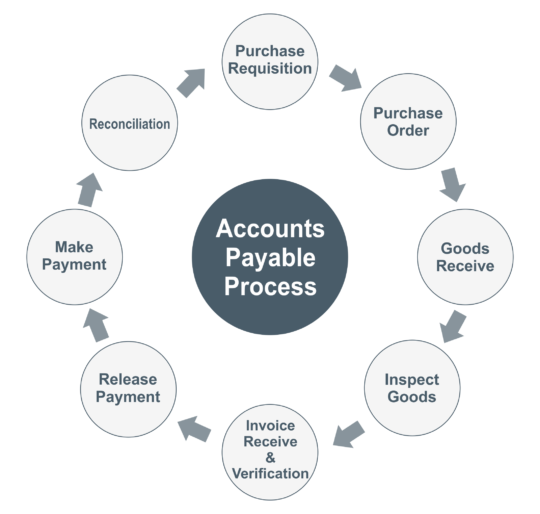Accounts Payable Process
Companies owed money to their supplier for goods and services purchased on credit. The payable amount appears in the company’s balance sheet as a current liability under sundry creditors.

1. Purchase Requisition
It is a request to procure the goods, based on requirement and considering delivery time frame, material store room person or purchase department can issue purchase requisition.
2. Purchase order
It is a document issued by the purchaser to the supplier and purchase order indicates a PO number, PO date, company name (Buyer), vendor name (Supplier), the person name and contact number from buyer side, description of the items being purchased, quantity, unit price of each, shipping method, ship to address, delivery time frame, payment terms and other information.
3. Goods Receive
The supplier should supply goods based on the terms and conditions mentioned in order and buyer need to check all goods have been received or not as per the purchase order.
4. Inspect Goods
It is an important activity after receiving of goods from the supplier, before accepting them into your stock, the buyer has to check the condition of goods, quantity and quality and who is receiving goods from the buyer side should sign on the delivery documents provided by the supplier.
5. Invoice Receive & Verification
Invoice verification is a process which confirms that invoice has been received and need to record in accounting system and needs to compare seller invoice with the purchase order like, quantity, price of each item, and total order value before making payment to vendor/supplier.
Accounting Entry
Purchase A/c Dr 1,00,000
Input CGST A/c @2.5% Dr 2,500
Input SGST A/c@2.5% Dr 2,500
To Vendor/Supplier A/c Dr 1,05,000
6. Release Payment
You should get approval from the superior to release the payment, based on payment terms between both parties, the buyer should release the payment on or before the due date.
7. Make Payment
Once you got approval from your superior then you have to write check on your vendor name or transfer the funds through NEFT/RTGS.
Example: Payment terms 30 days from the date of invoice.
Assume, Invoice date on 01.09.2016, payment terms are from the date of invoice 30 days and the payment due date is 30.09.2016.
Accounting Entry
Vendor/Supplier A/c Dr 1,05,000
To Bank Account 1,05,000
8. Reconciliation
You have to do the vendor or customer wise reconciliation if the ledger balances are not matching between buyer and supplier books of accounts.
Example
X has to pay 50,000 towards professional charges to Y, the ledger balance should match between both books of accounts.
In X books of accounts, payable amount to Y should be Rs.50,000/- and also in Y books of accounts, the receivable amount from X should be Rs.50,000. If the ledger balances are not matching in both books of accounts, and then you should take the transactions statement for the particular period from both books of accounts and need to verify each transaction wise is there any not recorded transactions.
If you forgot to include TDS line item while recording the transaction, then balance will not match in both books of accounts this is one of the reasons.
Entry in Service Receiver Books
Professional charges paid Dr 50,000
To TDS on professional charges 5,000
To Y Account 45,000
Payment Entry
Y Account Dr 45,000
To Bank A/c 45,000
Entry in Service Provider Books
X Account Dr 50,000
To Professional charges received 50,000
Bank A/c Dr 45,000
TDS receivable Dr 5,000
To X Account 50,000
Related Topics
Interest on Late Payment of TDS
Related Pages
- Fixed Asset Entries
- Payroll Journal Entries
- Accrued Expenses
- Prepaid Income
- Accounting Basics
- Debits and Credits
- Chart of Accounts
- Bookkeeping
- Petty Cash
- Bank Reconciliation
- Accounts Receivable Process
- Prepaid Expenses
- Discount Allowed and Discount Received
- Journal Entries
- Adjusting Entries
- Depreciation
- Current Liabilities and Current Assets